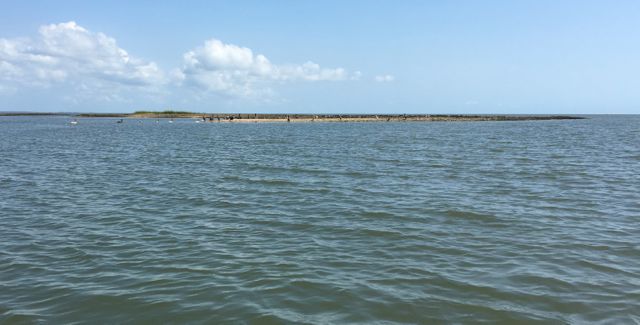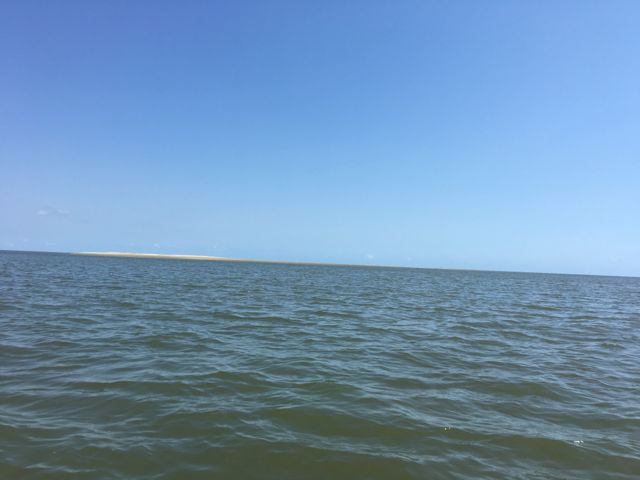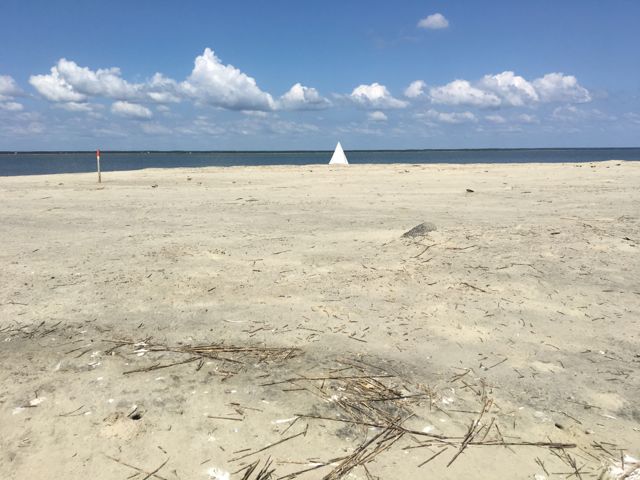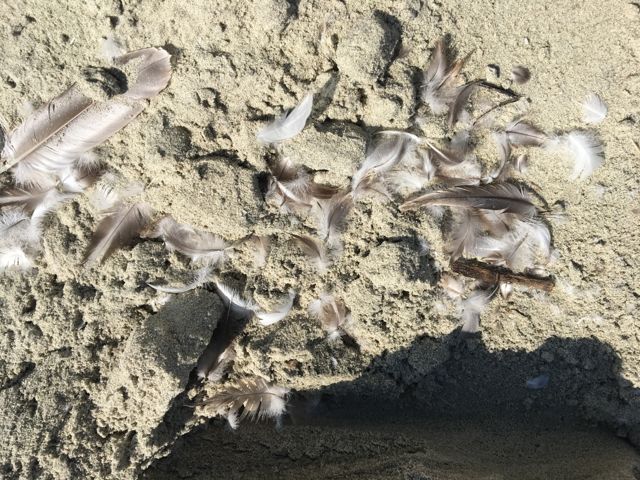I regretfully admit that Kingfisher was my second choice craft to venture out on the waters of Cape Romain. Plan A was to speed out to Bull Island on my Boston Whaler for a long hike, but ignition problems precluded this trip. I shed my disappointment to consider Plan B – sailing out on Kingfisher. Due to light winds, it was not an optimal sailing day, though a favorable tide would facilitate outward and return legs. I dispensed with the planned hike, and left gear behind to lighten the load: hiking shoes, pack, DSLR camera. The destination was vague, though I was reminded of my answer to a Publix cashier on my weekend plans: “Getting out on the water”. It was an opportunity to not be missed: beautiful clear weather, reduced humidity, and the fall equinox. On getting underway, I observed a pair of wood storks and a great blue heron soaring away from their roosts. These wading birds are now a common feature of the Lowcountry’s wildlife – not to be taken for granted.
As anticipated, I would be sailing to windward with the light east wind, tacking through Andersonville Creek and out Bulls Bay. Entering the Bay, many outboard crews were trying out their cast nets for shrimp. I stayed to port of the crowd, gradually finding open waters after scraping bottom on the oyster covered bottom past the point at the creek’s mouth. The waters were smooth enough to sit my lunch and water bottle on the deck as I sailed to windward. The Northeast Point of Bull Island loomed ahead, but my focus was on the sandy islet to the north of the island, known to me as Skimmer Key.
The waters were smooth enough to sit my lunch and water bottle on the deck as I sailed to windward. The Northeast Point of Bull Island loomed ahead, but my focus was on the sandy islet to the north of the island, known to me as Skimmer Key. 
I stood in Kingfisher’s cockpit for a different viewing perspective, and a ray or skate swam by just under the surface. Between the island and islet, large splashes exploded in the distance, though not the result of brown pelican dives. Large black breaching bodies were creating the splashes, appearing to be a large pod of bottlenose dolphins. The area covered by the dolphins was beyond capturing with my iPhone camera. Starboard tack allowed me to enter a channel stretching to the northeast and toward the islet. As I approached the tiny island, I noted that Closed Area signs had been removed, and nesting activities had finished some time ago.
After an easy landing I walked around this sandy bump. Compared to previous visits to this isle, the size of the island elevated above high tide appeared reduced. There was no evidence of plant colonization observed in recent years, though ghost crabs and their borrows were arrayed around the sands. (For a 2015 visit to this key see Lost Words.) At the high tide line were a mass of feathers ringing the island. I wondered if this accumulation was debris from the black skimmer nesting season.
There was no evidence of plant colonization observed in recent years, though ghost crabs and their borrows were arrayed around the sands. (For a 2015 visit to this key see Lost Words.) At the high tide line were a mass of feathers ringing the island. I wondered if this accumulation was debris from the black skimmer nesting season. The low tide exposed sandy shoals stretching out to the east-southeast and populated by roosting brown pelicans. A few feeding shorebirds ran around the intertidal area.
The low tide exposed sandy shoals stretching out to the east-southeast and populated by roosting brown pelicans. A few feeding shorebirds ran around the intertidal area.
I set sail for my return home. A dolphin pod appeared astern, and I headed back toward the island. Soon I was in their midst, and made an attempt at photographing the marine mammals.
Though bottlenose dolphins are common in Lowcountry waterways, their close and ongoing presence in this location made for a memorable encounter. Kingfisher’s quiet propulsion made it a first choice craft for these interactions. I soaked up the experience before turning Kingfisher’s stern to the east wind for the long run to shore.